The PVC UV stabilizer market is expected to grow from USD 254.7 million in 2025 to USD 407.0 million by 2035, reflecting a CAGR of 4.8%. The growth contribution index provides insight into the relative impact of various factors driving market expansion across this period. From 2025 to 2028, the primary contributors to growth include rising demand in construction, automotive, and packaging applications, where PVC products require enhanced weathering resistance and extended service life. The adoption of UV stabilizers in these industries mitigates degradation, discoloration, and brittleness, directly influencing incremental revenue growth and establishing a strong early market contribution.
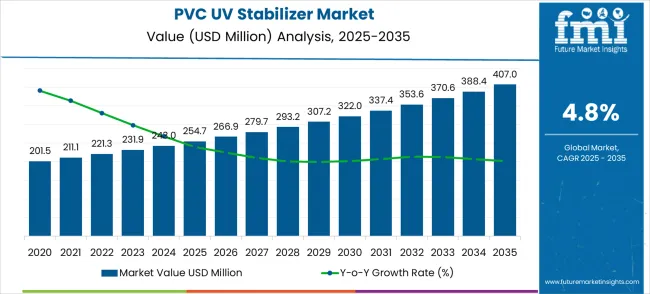
| Metric | Value |
|---|---|
| Market Value (2025) | USD 254.7 million |
| Market Forecast Value (2035) | USD 407.0 million |
| Forecast CAGR (2025-2035) | 4.8% |
Between 2028 and 2032, the contribution from technological innovations and new product formulations becomes more pronounced. Advanced stabilizers with improved compatibility, cost efficiency, and enhanced performance under extreme UV exposure drive broader adoption. Regulatory support promoting long-lasting, sustainable materials also amplifies growth, particularly in regions with high construction and automotive activity. From 2032 to 2035, the market maintains steady growth, supported by replacement demand and expansion into emerging economies where PVC usage is increasing. The growth contribution index highlights the cumulative effect of application adoption, technological improvement, and regional expansion on overall market size. Understanding these contributions enables manufacturers and investors to prioritize R&D, optimize product portfolios, and target high-impact applications to maximize market share and revenue capture throughout the decade.
The PVC UV stabilizer market is segmented across construction and building materials (40%), automotive and transportation (25%), electrical and electronic applications (16%), packaging industry (12%), and specialty applications including medical devices and consumer goods (7%). Construction materials dominate adoption as PVC-based products such as window profiles, pipes, and siding require protection from UV-induced degradation. Automotive and transportation applications leverage stabilizers for exterior trim, cables, and dashboards exposed to sunlight. Electrical and electronic industries use them in insulating materials and housings to maintain longevity. Packaging industries incorporate UV stabilizers for durable films and containers. Specialty applications focus on PVC components in medical equipment and consumer products requiring long-term stability.
Recent trends include advanced hindered amine light stabilizers (HALS), synergistic additive formulations, and nano-enhanced UV protection. Manufacturers are innovating with eco-friendly, non-toxic, and high-temperature-resistant stabilizers. Growth is driven by urban infrastructure expansion, automotive electrification, and demand for long-lasting consumer products. Collaborations between stabilizer producers and PVC manufacturers enable customized, high-performance, and durable solutions, supporting steady global market growth.
The PVC UV stabilizer market grows by enabling manufacturers to enhance polymer durability while accessing advanced protection technologies without substantial formulation complexity. Polymer manufacturers and processing companies face mounting pressure to improve product longevity and performance, with UV stabilizer systems typically providing 60-80% improvement in weathering resistance compared to unstabilized alternatives, making stabilization solutions essential for competitive product positioning. The polymer industry's need for reliable UV protection and application-specific stabilization creates demand for comprehensive stabilizer solutions that can provide enhanced durability, maintain processing characteristics, and ensure consistent performance without compromising material properties or processing conditions.
Government initiatives promoting sustainable polymer applications and advanced material technologies drive adoption in automotive, packaging, and construction applications, where reliable UV protection has a direct impact on product lifespan and performance standards. The raw material price volatility and the complexity of managing diverse stabilizer requirements may limit accessibility among smaller manufacturers and developing regions with limited technical infrastructure for advanced stabilizer formulation and application.
The PVC UV stabilizer market presents a steady growth trajectory, expanding from USD 254.7 million in 2025 to USD 407.0 million by 2035 at a 4.8% CAGR. As global industries prioritize polymer durability, regulatory compliance, and product longevity, UV stabilizers have evolved from optional additives to essential components ensuring PVC performance across automotive exteriors, outdoor packaging, agricultural films, and construction applications exposed to harsh environmental conditions.
The convergence of automotive industry expansion, packaging sustainability mandates, agricultural modernization, and construction material durability requirements creates sustained demand momentum. Advanced HALS technologies offering superior radical scavenging capabilities, cost-effective UV absorber systems, and specialized quencher formulations will capture market premiums, while geographic expansion into high-growth Asian markets and automotive sector penetration will drive volume leadership. Environmental regulations promoting polymer longevity and waste reduction provide structural support.
The market is segmented by stabilizer type, application, and region. By stabilizer type, the market is divided into HALS, UV Absorbers, Quenchers, and Others. Based on the application, the market is categorized into Automotive, Packaging, Personal Care, Agriculture, and Others. Regionally, the market is divided into Asia Pacific, Europe, North America, and other key regions.
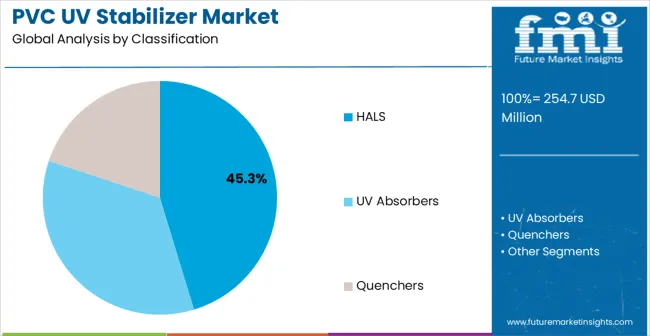
The HALS (Hindered Amine Light Stabilizers) segment represents the dominant force in the PVC UV stabilizer market, capturing approximately 45.3% of total market share in 2025. This advanced stabilizer category encompasses formulations featuring sophisticated radical scavenging and regenerative capabilities, including high-efficiency hindered amine systems and advanced polymeric stabilizers that enable superior UV protection and thermal stability across all processing conditions. The HALS segment's market leadership stems from its superior protection capabilities, with stabilizers capable of handling diverse polymer applications while maintaining consistent performance standards and processing compatibility across all operational conditions.
The UV Absorbers segment maintains a substantial 28.7% market share, serving customers who require reliable UV protection with enhanced processing stability features. These systems offer cost-effective solutions for medium-performance applications while providing sufficient protection capabilities to meet regional polymer processing and durability demands. The Quenchers segment accounts for approximately 15.4% market share, focusing on specialized applications requiring specific photochemical deactivation mechanisms. The remaining market segments, categorized as specialty or hybrid systems, account for approximately 10.6% of the market, serving niche applications requiring specific stabilizer configurations or specialized performance parameters.
Key technological advantages driving the HALS segment include:
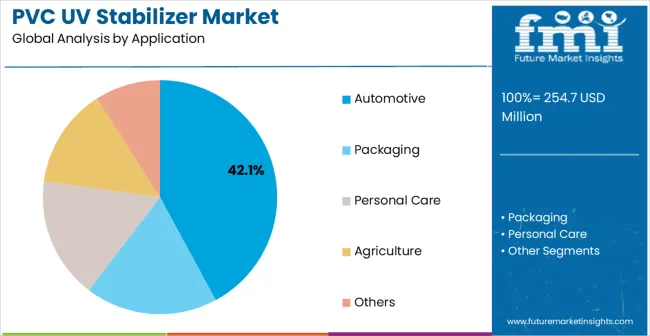
Automotive applications dominate the PVC UV stabilizer market with approximately 42.1% market share in 2025, reflecting the critical role of UV stabilization in supporting automotive component durability and performance requirements worldwide. The automotive segment's market leadership is reinforced by increasing vehicle production trends, advanced material requirements, and rising demand for long-lasting polymer components in exterior and interior automotive applications across developed and emerging markets.
The Packaging segment represents the second-largest application category, capturing 26.8% market share through specialized stabilizer requirements for food contact applications, flexible packaging systems, and consumer goods protection applications. This segment benefits from growing demand for sustainable packaging solutions that meet specific regulatory requirements, food safety standards, and performance protocols in challenging environmental conditions.
The Personal Care segment accounts for 13.5% market share, serving cosmetic packaging, personal care product containers, and specialized consumer applications across multiple market sectors. Agriculture applications represent 10.2% market share, focusing on greenhouse films, irrigation systems, and outdoor agricultural equipment requiring UV protection. The Others segment captures 7.4% market share, encompassing construction, industrial, and specialized applications.
Key market dynamics supporting application growth include:
The market is driven by three concrete demand factors tied to polymer performance outcomes. First, automotive industry growth and advanced material requirements create increasing demand for high-performance UV stabilization systems, with automotive polymer applications expanding by 8-12% annually in major developing countries worldwide, requiring comprehensive stabilizer infrastructure. Second, regulatory initiatives promoting sustainable polymer applications and advanced material technologies are driving the increased adoption of stabilizer solutions, with many industries implementing strict durability standards for polymer applications by 2030. Third, technological advancements in stabilizer chemistry and polymer protection enable more effective and cost-efficient stabilization solutions that reduce material degradation while improving processing characteristics and application performance standards.
Market restraints include high research and development investment requirements for stabilizer innovation that can deter new market entrants from developing comprehensive stabilizer portfolios, particularly in developing regions where funding for chemical research and development remains limited. Raw material price volatility poses another significant challenge, as fluctuations in key chemical intermediates can create cost pressures and margin compression, potentially causing increased product costs and competitive disadvantages. Regulatory complexity and approval requirements across different regions create additional operational challenges for stabilizer manufacturers, demanding ongoing investment in regulatory compliance and technical documentation capabilities.
Key trends indicate accelerated adoption in Asia-Pacific markets, particularly China and India, where rapid industrialization and polymer processing expansion drive comprehensive UV stabilizer system adoption. Technology integration trends toward advanced stabilizer formulations with synergistic effects, improved processing compatibility, and integrated performance enhancement systems enable proactive protection approaches that reduce polymer degradation and extend application lifespans. The market thesis could face disruption if alternative polymer protection methods or significant changes in material selection approaches minimize reliance on traditional UV stabilization technologies.
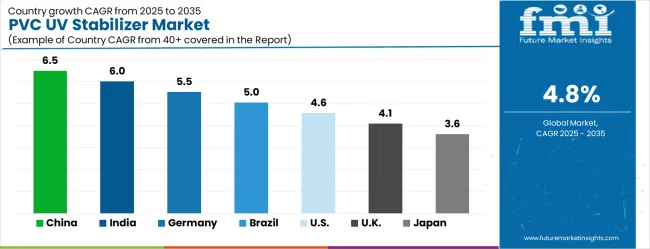
| Country | CAGR (2025-2035) |
|---|---|
| China | 6.5% |
| India | 6.0% |
| Germany | 5.5% |
| Brazil | 5.0% |
| USA | 4.6% |
| UK | 4.1% |
| Japan | 3.6% |
The PVC UV stabilizer market is gaining momentum worldwide, with China taking the lead thanks to massive industrial expansion and government-backed polymer manufacturing modernization programs. Close behind, India benefits from expanding automotive activities and industrial development initiatives, positioning itself as a strategic growth hub in the Asia-Pacific region. Germany shows steady advancement, where integration of advanced stabilizer technologies strengthens its role in the European chemical supply chain. Brazil is focusing on automotive modernization and industrial development, signaling an ambition to capitalize on the growing opportunities in South American polymer markets. Meanwhile, the USA stands out for its advanced technology adoption in existing chemical operations, and the UK and Japan continue to record consistent progress in stabilizer modernization. Together, China and India anchor the global expansion story, while the rest build stability and diversity into the market's growth path.
The report covers an in-depth analysis of 40+ countries, Top-performing countries are highlighted below.
China demonstrates the strongest growth potential in the PVC UV Stabilizer Market with a CAGR of 6.5% through 2035. The country's leadership position stems from massive industrial development projects, government-backed chemical manufacturing modernization programs, and stringent quality regulations driving the adoption of advanced stabilizer solutions. Growth is concentrated in major industrial areas, including Beijing, Shanghai, Guangzhou, and Shenzhen, where polymer processing and manufacturing facilities are implementing advanced UV stabilizer solutions for enhanced product durability and processing efficiency. Distribution channels through state-owned chemical enterprises and government-approved manufacturers expand deployment across automotive projects and industrial development initiatives. The country's Made in China 2025 strategy provides policy support for chemical industry modernization, including advanced stabilizer system adoption.
Key market factors:
In Mumbai, Delhi, Bangalore, and Chennai, the adoption of comprehensive UV stabilizer solutions is accelerating across automotive applications and industrial manufacturing initiatives, driven by rapid industrialization and government manufacturing programs. The market demonstrates strong growth momentum with a CAGR of 6.0% through 2035, linked to comprehensive industrial development and increasing focus on quality polymer applications. Indian manufacturers are implementing advanced stabilizer systems and protection platforms to enhance product durability while meeting growing demand in expanding automotive development and packaging sectors. The country's National Manufacturing Policy creates sustained demand for UV stabilizer solutions, while increasing emphasis on export quality drives adoption of advanced polymer protection systems.
Germany's advanced chemical sector demonstrates sophisticated implementation of UV stabilizer solutions, with documented case studies showing 40% performance improvement in polymer applications through intelligent stabilizer formulation platforms. The country's chemical infrastructure in major industrial centers, including Munich, Berlin, Hamburg, and Frankfurt, showcases integration of advanced stabilizer technologies with existing polymer processing systems, leveraging expertise in chemical engineering and polymer technologies. German manufacturers emphasize quality and precision standards, creating demand for high-performance stabilizer solutions that support continuous improvement initiatives and processing optimization requirements. The market maintains steady growth through focus on Industry 4.0 integration and sustainability compliance, with a CAGR of 5.5% through 2035.
Key development areas:
Brazil's market expansion is driven by diverse automotive demand, including vehicle manufacturing in São Paulo and automotive components in other major cities, and comprehensive industrial modernization across multiple states. The country demonstrates promising growth potential with a CAGR of 5.0% through 2035, supported by federal government industrial investment programs and state-level manufacturing development initiatives. Brazilian manufacturers face implementation challenges related to raw material availability and technical expertise requirements, requiring phased deployment approaches and support from international suppliers. The growing automotive demands and industrial efficiency requirements create compelling business cases for the adoption of UV stabilizers, particularly in urban areas where product quality has a direct impact on market competitiveness.
Market characteristics:
The USA market leads in advanced UV stabilizer innovation based on integration with intelligent polymer processing systems and smart manufacturing technologies for enhanced operational efficiency. The country shows strong potential with a CAGR of 4.6% through 2035, driven by the modernization of existing chemical infrastructure and the expansion of technology-enabled manufacturing facilities in major industrial areas, including Texas, California, Illinois, and Ohio. American manufacturers are adopting intelligent stabilizer systems for performance improvement and regulatory compliance, particularly in regions with strict environmental standards and advanced automotive requirements demanding comprehensive material upgrades. Technology deployment channels through established chemical contractors and direct supplier relationships expand coverage across polymer processing facilities and manufacturing operators.
Leading market segments:
In London, Manchester, Birmingham, and Glasgow, chemical facilities are implementing comprehensive UV stabilizer solutions to modernize existing polymer processing infrastructure and improve product quality, with documented case studies showing a 25% reduction in material degradation through advanced stabilizer systems.
The market shows moderate growth potential with a CAGR of 4.1% through 2035, linked to the ongoing modernization of chemical facilities, processing networks, and emerging advanced manufacturing projects in major cities. British manufacturers are adopting intelligent stabilizer and monitoring platforms to enhance product reliability while maintaining quality standards demanded by the automotive and packaging industries. The country's established chemical infrastructure creates sustained demand for stabilizer upgrade and modernization solutions that integrate with existing processing systems.
Market development factors:
Japan's PVC UV Stabilizer Market demonstrates sophisticated implementation focused on precision formulation and operational excellence optimization, with documented integration of advanced chemical systems, achieving 35% improvement in polymer durability across automotive and industrial facilities. The country maintains steady growth momentum with a CAGR of 3.6% through 2035, driven by chemical facilities' emphasis on quality standards and continuous improvement methodologies that align with lean manufacturing principles applied to polymer processing operations. Major metropolitan areas, including Tokyo, Osaka, Nagoya, and Fukuoka, showcase advanced deployment of intelligent stabilizer platforms where chemical systems integrate seamlessly with existing polymer processing control systems and comprehensive quality management programs.
Key market characteristics:
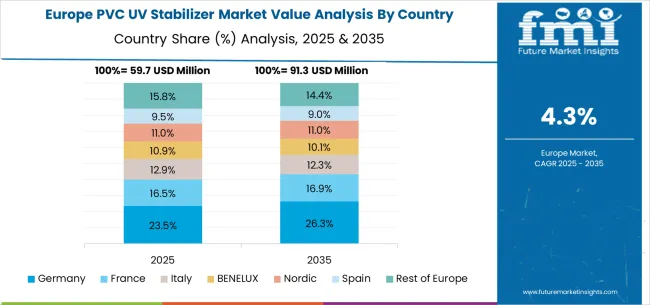
The PVC UV stabilizer market in Europe is projected to grow from USD 63.7 million in 2025 to USD 101.8 million by 2035, registering a CAGR of 4.8% over the forecast period. Germany is expected to maintain its leadership position with a 32.4% market share in 2025, declining slightly to 31.8% by 2035, supported by its extensive chemical infrastructure and major industrial centers, including Munich, Berlin, and Frankfurt chemical facilities.
The United Kingdom follows with a 19.2% share in 2025, projected to reach 19.6% by 2035, driven by comprehensive chemical modernization programs in London, Manchester, and other industrial areas implementing advanced stabilizer systems. France holds a 17.8% share in 2025, expected to maintain 17.4% by 2035 through the ongoing development of chemical facilities and polymer processing networks. Italy commands a 13.6% share, while Spain accounts for 10.2% in 2025. The Rest of Europe region is anticipated to gain momentum, expanding its collective share from 6.8% to 8.4% by 2035, attributed to increasing UV stabilizer adoption in Nordic countries and emerging Eastern European chemical facilities implementing industrial development programs.
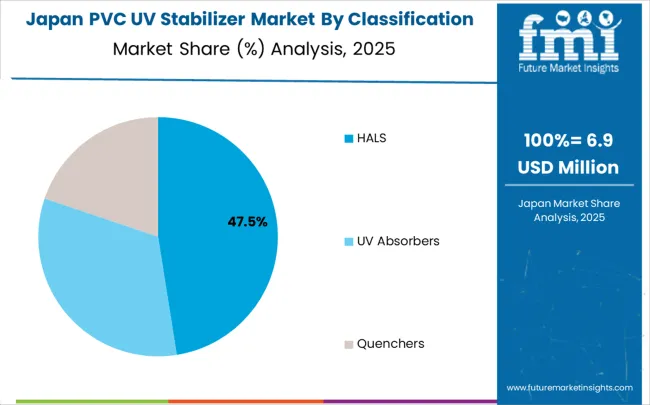
The Japanese PVC UV Stabilizer Market demonstrates a mature and precision-focused landscape, characterized by sophisticated integration of HALS stabilizer systems with existing polymer processing infrastructure across industrial facilities, chemical supply networks, and automated production lines. Japan's emphasis on operational excellence and quality standards drives demand for high-reliability UV stabilizer solutions that support kaizen continuous improvement initiatives and statistical process control requirements in polymer processing operations.
The market benefits from strong partnerships between international stabilizer providers like BASF, Clariant, and domestic chemical leaders, including Mitsubishi Chemical, Sumitomo Chemical, and Shin-Etsu Chemical, creating comprehensive service ecosystems that prioritize stabilizer effectiveness and operator training programs. Chemical centers in Tokyo, Osaka, Nagoya, and other major industrial areas showcase advanced quality control implementations where stabilizer systems achieve 98% effectiveness through integrated monitoring programs.
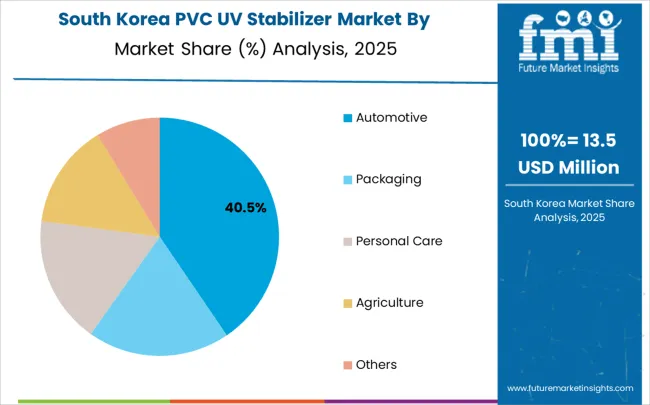
The South Korean PVC UV Stabilizer Market is characterized by strong international technology provider presence, with companies like BASF, Clariant AG, and SONGWON Industrial maintaining dominant positions through comprehensive system integration and technical services capabilities for chemical facilities and polymer processing applications. The market is demonstrating a growing emphasis on localized technical support and rapid response capabilities, as Korean manufacturers increasingly demand customized solutions that integrate with domestic chemical infrastructure and advanced processing control systems deployed across the Seoul Metropolitan Area and other major industrial cities.
Local chemical companies and regional service integrators are gaining market share through strategic partnerships with global providers, offering specialized services including technical training programs and certification services for stabilizer application specialists. The competitive landscape shows increasing collaboration between multinational stabilizer companies and Korean chemical technology specialists, creating hybrid service models that combine international chemical expertise with local market knowledge and customer relationship management.
The PVC UV Stabilizer Market features approximately 25-35 meaningful players with moderate concentration, where the top three companies control roughly 32-38% of global market share through established stabilizer portfolios and extensive chemical industry relationships. Competition centers on product performance, technical support capabilities, and formulation expertise rather than price competition alone.
Market leaders include BASF, Rianlon, and Syensqo, which maintain competitive advantages through comprehensive stabilizer solution portfolios, global distribution networks, and deep expertise in the polymer and chemical sectors, creating high switching costs for customers. These companies leverage established supplier relationships and ongoing technical support contracts to defend market positions while expanding into adjacent polymer and chemical applications.
Challengers encompass SONGWON Industrial and ADEKA, which compete through specialized stabilizer solutions and strong regional presence in key chemical markets. Technology specialists, including Clariant AG, Arkema, and SI Group, focus on specific stabilizer technologies or vertical applications, offering differentiated capabilities in advanced formulations, specialty chemicals, and application-specific solutions.
Regional players and emerging chemical providers create competitive pressure through cost-effective solutions and rapid deployment capabilities, particularly in high-growth markets including China and India, where local presence provides advantages in customer support and regulatory compliance. Market dynamics favor companies that combine advanced stabilizer technologies with comprehensive technical services that address the complete product lifecycle from formulation through ongoing application support and optimization.
| Item | Value |
|---|---|
| Quantitative Units | USD 254.7 million |
| Stabilizer Type | HALS, UV Absorbers, Quenchers, Others |
| Application | Automotive, Packaging, Personal Care, Agriculture, Others |
| Regions Covered | Asia Pacific, Europe, North America, Latin America, Middle East & Africa |
| Country Covered | China, India, Germany, Brazil, the USA, the UK, Japan, and 40+ countries |
| Key Companies Profiled | BASF, Rianlon, Syensqo, SONGWON Industrial, ADEKA, SABO S.p.A., Arkema, Clariant AG, Everlight Chemical Industrial, SI Group, Mayzo, 3V Sigma S.p.A., Lycus, Suqian Unitech, SINOPCC |
| Additional Attributes | Dollar sales by stabilizer type and application categories, regional adoption trends across Asia Pacific, Europe, and North America, competitive landscape with stabilizer providers and service integrators, polymer processing requirements and specifications, integration with advanced manufacturing initiatives and quality control platforms, innovations in stabilizer technology and protection systems, and development of specialized applications with performance and durability capabilities. |
How big is the PVC UV Stabilizer market in 2025?
The global PVC UV Stabilizer market is valued at USD 254.7 million in 2025.
What will be the size of the PVC UV Stabilizer market in 2035?
The size of the PVC UV Stabilizer market is projected to reach USD 407.0 million by 2035.
How much will the PVC UV Stabilizer market grow between 2025 and 2035?
The PVC UV Stabilizer market is expected to grow at a 4.8% CAGR between 2025 and 2035.
What are the key stabilizer type segments in the PVC UV Stabilizer market?
The key stabilizer type segments in the PVC UV Stabilizer market are HALS, UV Absorbers, Quenchers, and Others.
Which application segment is expected to contribute a significant share to the PVC UV Stabilizer market in 2025?
In terms of application, the Automotive segment is set to command the dominant share in the PVC UV Stabilizer market in 2025.
The global PVC UV stabilizer market is estimated to be valued at USD 254.7 million in 2025.
The market size for the PVC UV stabilizer market is projected to reach USD 407.0 million by 2035.
The PVC UV stabilizer market is expected to grow at a 4.8% CAGR between 2025 and 2035.
The key product types in PVC UV stabilizer market are hals, UV absorbers and quenchers.
In terms of application, automotive segment to command 42.1% share in the PVC UV stabilizer market in 2025.






Our Research Products

The "Full Research Suite" delivers actionable market intel, deep dives on markets or technologies, so clients act faster, cut risk, and unlock growth.

The Leaderboard benchmarks and ranks top vendors, classifying them as Established Leaders, Leading Challengers, or Disruptors & Challengers.

Locates where complements amplify value and substitutes erode it, forecasting net impact by horizon

We deliver granular, decision-grade intel: market sizing, 5-year forecasts, pricing, adoption, usage, revenue, and operational KPIs—plus competitor tracking, regulation, and value chains—across 60 countries broadly.

Spot the shifts before they hit your P&L. We track inflection points, adoption curves, pricing moves, and ecosystem plays to show where demand is heading, why it is changing, and what to do next across high-growth markets and disruptive tech

Real-time reads of user behavior. We track shifting priorities, perceptions of today’s and next-gen services, and provider experience, then pace how fast tech moves from trial to adoption, blending buyer, consumer, and channel inputs with social signals (#WhySwitch, #UX).

Partner with our analyst team to build a custom report designed around your business priorities. From analysing market trends to assessing competitors or crafting bespoke datasets, we tailor insights to your needs.
Supplier Intelligence
Discovery & Profiling
Capacity & Footprint
Performance & Risk
Compliance & Governance
Commercial Readiness
Who Supplies Whom
Scorecards & Shortlists
Playbooks & Docs
Category Intelligence
Definition & Scope
Demand & Use Cases
Cost Drivers
Market Structure
Supply Chain Map
Trade & Policy
Operating Norms
Deliverables
Buyer Intelligence
Account Basics
Spend & Scope
Procurement Model
Vendor Requirements
Terms & Policies
Entry Strategy
Pain Points & Triggers
Outputs
Pricing Analysis
Benchmarks
Trends
Should-Cost
Indexation
Landed Cost
Commercial Terms
Deliverables
Brand Analysis
Positioning & Value Prop
Share & Presence
Customer Evidence
Go-to-Market
Digital & Reputation
Compliance & Trust
KPIs & Gaps
Outputs
Full Research Suite comprises of:
Market outlook & trends analysis
Interviews & case studies
Strategic recommendations
Vendor profiles & capabilities analysis
5-year forecasts
8 regions and 60+ country-level data splits
Market segment data splits
12 months of continuous data updates
DELIVERED AS:
PDF EXCEL ONLINE
PVC-M High Impact Resistant Water Supply Pipe Market Size and Share Forecast Outlook 2025 to 2035
PVC Electrical Conduit Market Size and Share Forecast Outlook 2025 to 2035
PVC Cling Film Market Size and Share Forecast Outlook 2025 to 2035
PVC Tapes Market Size and Share Forecast Outlook 2025 to 2035
PVC Footwear Market Analysis by Growth, Trends and Forecast from 2025 to 2035
PVC Packing Straps Market Report – Key Trends & Forecast 2025 to 2035
Market Share Insights of PVC-Free Cap Liner Manufacturers
Leading Providers & Market Share in PVC Tapes Industry
PVC Cling Wrap Market Trends & Growth Forecast 2024-2034
PVC Blister Packs Market
PVC Container Market
PVC-Free Packaging Market
PVC-free Cap Liners Market
Alu-PVC Blister Packaging Market Size and Share Forecast Outlook 2025 to 2035
Non PVC Plasticizers Market Growth & Outlook 2022 to 2032
Rewritable PVC Cards Market
Residential PVC Electrical Conduit Market Size and Share Forecast Outlook 2025 to 2035
Polyvinyl Chloride (PVC) Packaging Film Market Forecast and Outlook 2025 to 2035
UVC Upper Air Disinfection Unit Market Size and Share Forecast Outlook 2025 to 2035
UVC Surface Disinfection System Market Size and Share Forecast Outlook 2025 to 2035

Thank you!
You will receive an email from our Business Development Manager. Please be sure to check your SPAM/JUNK folder too.
Chat With
MaRIA